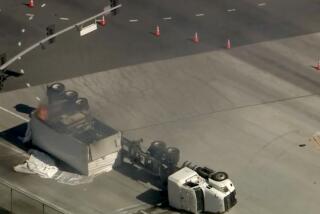Harbor Freeway Double-Decking Gets Under Way
Harbor Freeway motorists, long accustomed to seeing red because of fierce rush-hour traffic congestion, should soon be seeing double as well.
Preliminary work on the double-decking of a 1.5-mile segment of the freeway is due to begin in earnest today with the temporary closure of two ramps for reconstruction, according to Caltrans officials.
If the futuristic project--the first of its kind in Los Angeles--moves ahead on schedule, two elevated stretches totaling 2.25-miles will be opened for buses and car pools in 1993, according to officials. The first two-lane-wide, T-shaped structure will be built in the freeway median between Martin Luther King Jr. Boulevard and Slauson Avenue; a second will stretch from Jefferson Boulevard to 23rd Street.
Highlight of Project
The double-decking, a concept once considered outlandish, is a highlight of a $548-million Harbor Transitway project aimed at providing almost 20 miles of mass transit improvements on the freeway from San Pedro to the Santa Monica Freeway.
On a 10.3-mile stretch north of the Artesia Freeway, two exclusive-use lanes will be provided for buses and car pools by widening the existing roadway and by constructing the elevated structure. The Transitway project is also due to include nine bus stops--one with an elevated link flowing directly into the exclusive-use lane at the junction of the Harbor and Artesia freeways--and eight adjacent park-and-ride lots.
The double decks, which state transit engineers prefer to call âviaductsâ since they do not stretch across the entire roadway, will rise as high as 75 feet above the freewayâs median strip. The new structures will be 67 feet wide.
Caltrans senior transportation engineer William Charbonneau said the elevated roadway âis cheaper to build than purchasing right-of-wayâ alongside the freeway. Yet it is also far more expensive than widening the current roadway, he added. Consequently, the two-lane addition--one lane northbound and one southbound--will be elevated only in the 2.25-mile stretch where there is no room to widen the existing roadway.
$50-Million Contract
The entire federally funded Transitway project is subdivided into 16 segments, with the Martin Luther King/Slauson elevation included in a $50-million contract with C. C. Meyers Construction Co.
The first portion of the project to directly affect motorists begins this morning with the closure of the northbound Vernon Avenue off-ramp and the northbound 51st Street on-ramp for about three weeks. Beginning Friday, the southbound Vernon Avenue on-ramp and the southbound 51st Street off-ramp will also be closed for three weeks for reconstruction work that will help accommodate the elevated roadway.
Over the next few months, various lanes of the freeway will be closed from 8 p.m. to 5 a.m. for work that will including construction of the deck, officials said.
âWe are hoping to keep the traffic congestion in normal commuting hours to a bare minimum,â Caltrans spokesman Thomas Knox said Wednesday. âWe are hoping not to expect (too many) tie-ups, because a good deal of the work will be done in the evening.â
Widening Under Way
Concrete crash barriers and âgawkerâ screens have already been placed beside the freewayâs outside lanes to help expedite the work, officials said. Road widening is also currently under way on southbound lanes from Gage Avenue south to 92nd Street and south of Rosecrans Avenue.
The Harbor Freeway currently carries more than 230,000 vehicles a day, with cars crawling at less than 15 m.p.h. during portions of the morning and evening rush hours. As traffic increases steadily each year, state officials are hoping to divert more commuters to mass transit. In the year 2005, Caltrans predicts, 65,000 commuters will take buses along the Transitway, and another 39,000 will participate in car pools.
Multilevel highways and bridges that include full double decks are in operation from San Francisco, home of the Embarcadero Freeway, to New York, the site of the George Washington Bridge. But only in Austin, Tex., and a handful of other places has a second deck been built above or below existing lanes of traffic.
More to Read
Sign up for Essential California
The most important California stories and recommendations in your inbox every morning.
You may occasionally receive promotional content from the Los Angeles Times.










